Chemistry > EXAM REVIEW > Marking scheme: Learning Grids For A Level Year 2 OCR Chemistry A Module 5: Physical chemistry and t (All)
Marking scheme: Learning Grids For A Level Year 2 OCR Chemistry A Module 5: Physical chemistry and transition elements. With complete Questions and Answers.
Document Content and Description Below
Module 5: Physical Chemistry and Transition Elements 5.1.1 How Fast? Question Answer H o w F a s t ? What is meant by the ‘rate of a reaction’? The change in concentration (of a reactan... t or a product) with time What is meant by the ‘order of a reaction’? The power that a concentration is raised to in the rate equation How is the overall order of a reaction determined? The overall order of a reaction is the sum of all the orders in the rate equation. Determine the order of reaction for each of the following rate/concentration graphs: A = first order B = zero order C = second order Learning Grids for OCR A Level Year 2 Chemistry: Module 5 Page 1 of 4744 © ZigZag Education, 2017 Oxford: pp. 8–27 Pearson: pp. 10–22 1 A B concentration rate rate concentration C rate concentration Question Answer H o w F a s t ? (c o n tin u e d) How would you determine the rate constant k for the first order reaction represented in the graph above? k = gradient of rate/concentration graph What is meant by the ‘rate determining step’ in a reaction? The slowest step in a multistep reaction mechanism A chemical reaction was carried out using two different concentrations of a reactant J. Experiment number Initial [J] (mol dm–3) Initial rate of reaction (mol dm–3 s –1) 1 0.0200 2.70 × 10–3 2 0.0800 4.32 × 10–2 Using the experimental data above, determine the increase in initial concentration of [J] between experiments 1 and 2 and the effect this has on the initial rate. From this information, determine the order for J. 0.0800/0.0200 = 4 Fourfold increase in initial concentration 4.32×10–2/2.70×10–3 = 16 Sixteenfold increase in rate = 42 increase in reaction rate Therefore, reaction is second order with respect to J Learning Grids for OCR A Level Year 2 Chemistry: Module 5 Page 2 of 4744 © ZigZag Education, 2017 Question Answer H o w F a s t ? (c o n tin u e d) A reaction takes place between three reactants, W, V and X, to make Y. W + V + X → Y Use the following information about the multistep reaction to calculate the order for the three reactants involved. Experiment number Initial [W] (mol dm–3) Initial [V] (mol dm–3) Initial [X] (mol dm–3) Initial rate of reaction (mol dm–3 s –1) 1 0.00600 0.00600 0.00600 3.60 × 10–5 2 0.01200 0.00600 0.00600 7.20 × 10–5 3 0.00600 0.01800 0.00600 3.24 × 10–4 4 0.01800 0.00600 0.0180 1.08 × 10–4 Reaction is first order with respect to [W] as doubling the initial concentration doubles the rate of the reaction. The reaction is second order with respect to [V] as increasing the concentration of [V] by three times increases the rate of reaction by nine (i.e. 32 ). The reaction is zeroth order with respect to [X] as tripling the concentration of W and tripling the concentration of X increases the rate by three. We have already worked out that the reaction is first order with respect to W, so the rate being tripled is due to W, and tripling the [X] is having no effect. What is the overall rate equation for this reaction? V ¿ 2 rate=k [W ] ¿ Calculate the rate constant for experiment 1. State your answer to 2 decimal places. V ¿ 2 ¿ [W ] ¿ k= rate ¿ What are the units for the rate constant for this reaction? V ¿ 2 ¿ mol dm−3 ¿ 2 ¿ [mol dm−3 ] ¿ [W ] ¿ units= rate ¿ Learning Grids for OCR A Level Year 2 Chemistry: Module 5 Page 3 of 4744 © ZigZag Education, 2017 Question Answer H o w F a s t ? (c o n tin u e d) Knowing that this is a multistep reaction, and using your knowledge of the rate equation for this reaction, determine how many molecules of each species are involved in the ratedetermining step. From the rate equation, one molecule of W and two molecules of V. Based on your knowledge of the rate-determining step, propose a mechanism for this multistep reaction that involves an intermediate, Z. Rate-determining step must involve the species in the rate equation Step 1: W +2V → Z Compared to the equation W +V +X →Y We can see that the second step must: Use up a molecule of X Use up the intermediate, Z Make a molecule of V to cancel out one of the molecules of V in the first step so that only one is used overall Make a molecule of Y Step 2: X+Z→V +Y Learning Grids for OCR A Level Year 2 Chemistry: Module 5 Page 4 of 4744 © ZigZag Education, 2017 Question Answer H o w F a s t ? (c o n tin u e d) Sketch the shape of the concentration–time graph you would expect for a reactant [W] in the reaction above. Graph should be a sketch of a constant half-life (first order reaction), such as: How can a concentration–time graph be used to determine the rate of a reaction at different times? Draw a tangent to the curve at a particular time. Calculate the gradient of the tangent. Learning Grids for OCR A Level Year 2 Chemistry: Module 5 Page 5 of 4744 © ZigZag Education, 2017 Concentration Time Question Answer What shape would you expect the rate–concentration graph to be for the reactant [V]? Sketch a graph to illustrate this. A positive gradient with a curved line for second order reaction H o w F a s t ? (c o n tin u e d) The results of this reaction were determined using the initial rates method. Describe an experimental method that could have been used to achieve these results. A ‘clock reaction’ where the time (t) is measured for an amount of product to form or for an amount of reactant to disappear. The initial rate is proportional to 1/t. This is carried out for each reactant in an experiment then a graph is plotted of initial rate against concentration. In the reaction above, the product of this reaction (Y) is a solid. What observation could you look for when calculating the initial rate? The formation of a precipitate In a different reaction, the product produced is a coloured solution. How can this observation be monitored? By use of colorimetry [Show More]
Last updated: 1 year ago
Preview 1 out of 47 pages
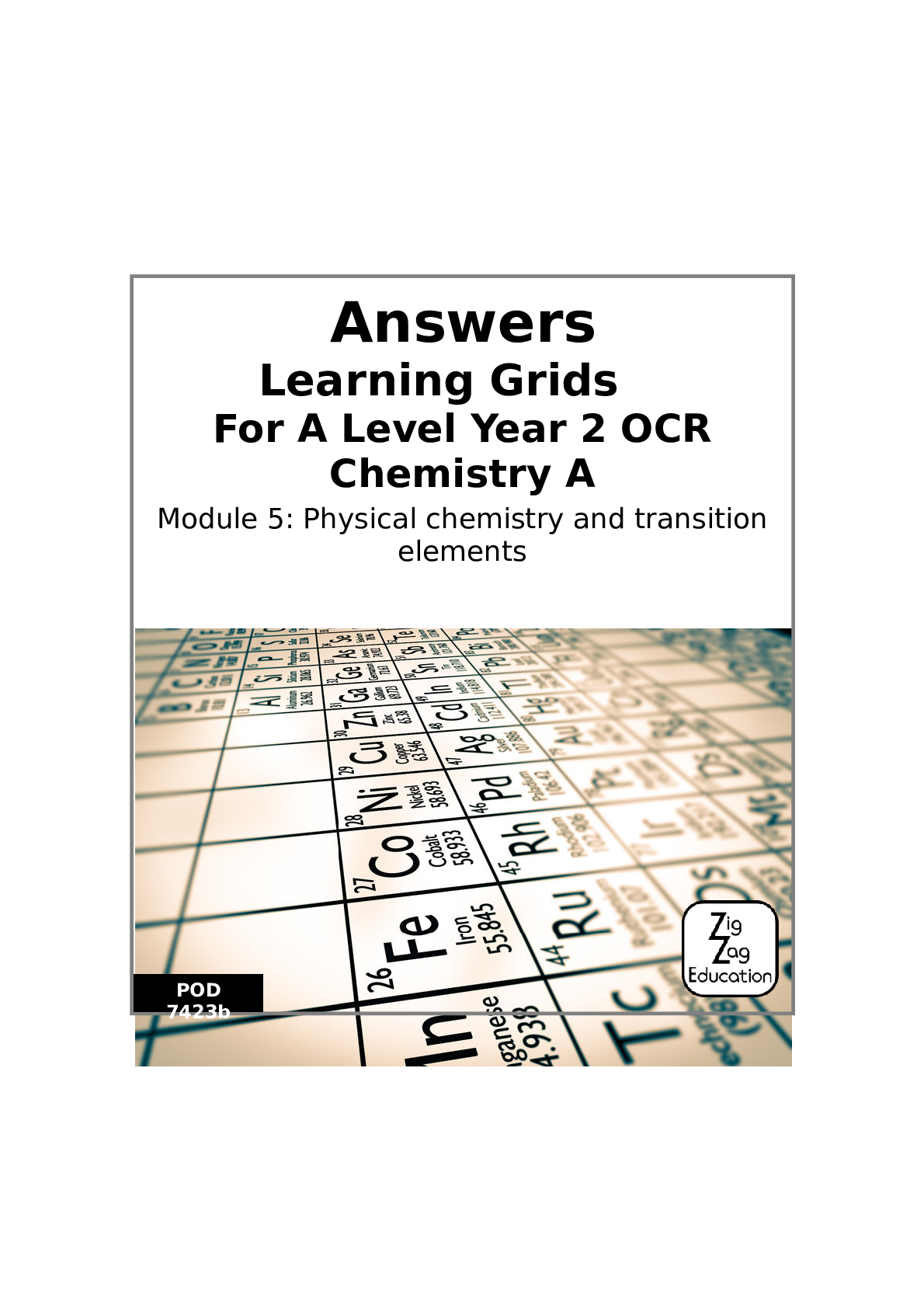
Reviews( 0 )
Recommended For You
*NURSING> EXAM REVIEW > 2022 NEW ACTIAL UPDATE EXAM FOR PHARMACOLOGY II (MUSCULOSKELETAL) COMPLETE QUESTIONS AND ANSWERS (All)
2022 NEW ACTIAL UPDATE EXAM FOR PHARMACOLOGY II (MUSCULOSKELETAL) COMPLETE QUESTIONS AND ANSWERS
2022 NEW ACTIAL UPDATE EXAM FOR PHARMACOLOGY II (MUSCULOSKELETAL) COMPLETE QUESTIONS AND ANSWERS
By YongSam , Uploaded: Apr 20, 2022
$14
*NURSING> EXAM REVIEW > APEA WOMEN'S HEALTH EXAM COMPLETE QUESTIONS AND ANSWERS ALL WITH EXPLANATIONS CHAMBERLAIN OF COLLEGE NURSING. (All)
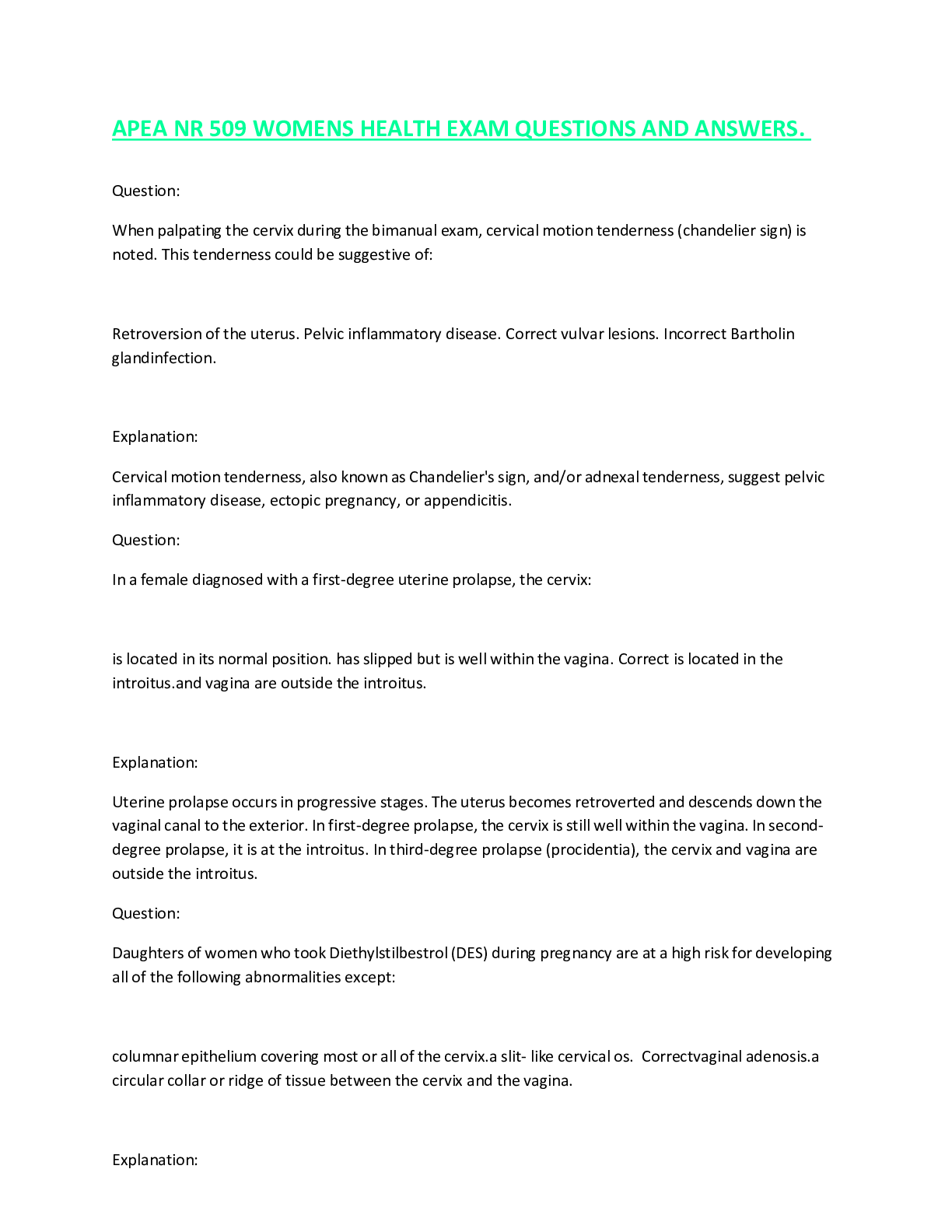
APEA WOMEN'S HEALTH EXAM COMPLETE QUESTIONS AND ANSWERS ALL WITH EXPLANATIONS CHAMBERLAIN OF COLLEGE NURSING.
APEA WOMEN'S HEALTH EXAM COMPLETE QUESTIONS AND ANSWERS ALL WITH EXPLANATIONS CHAMBERLAIN OF COLLEGE NURSING. CHAMBERLAIN OF COLLEGE NURSING CHAMBERLAIN OF COLLEGE NURSING CHAMBERLAIN OF COLLEGE NURSI...
By Acesolutions , Uploaded: Jan 19, 2022
$13
*NURSING> EXAM REVIEW > FUNDAMENTALS 512 COMPLETE QUESTIONS AND ANSWERS CORRECTLY ANSWERED AND GRADED A+REVISED CHAMBERLAIN COLLEGE (All)

FUNDAMENTALS 512 COMPLETE QUESTIONS AND ANSWERS CORRECTLY ANSWERED AND GRADED A+REVISED CHAMBERLAIN COLLEGE
FUNDAMENTALS 512 COMPLETE QUESTIONS AND ANSWERS (GRADE A) REVISED CHAMBERLAIN COLLEGE 1.) A nurse is caring for a client who is postoperative following a urinary diversion to treat bladder cancer....
By TOP STUDY , Uploaded: May 24, 2021
$8
*NURSING> EXAM REVIEW > Test Bank - Psychiatric Mental Health Nursing by Mary Townsend / all chapters complete questions and answers / Test Bank - Psychiatric Mental Health Nursing by Mary Townsend (9th Edition) (All)
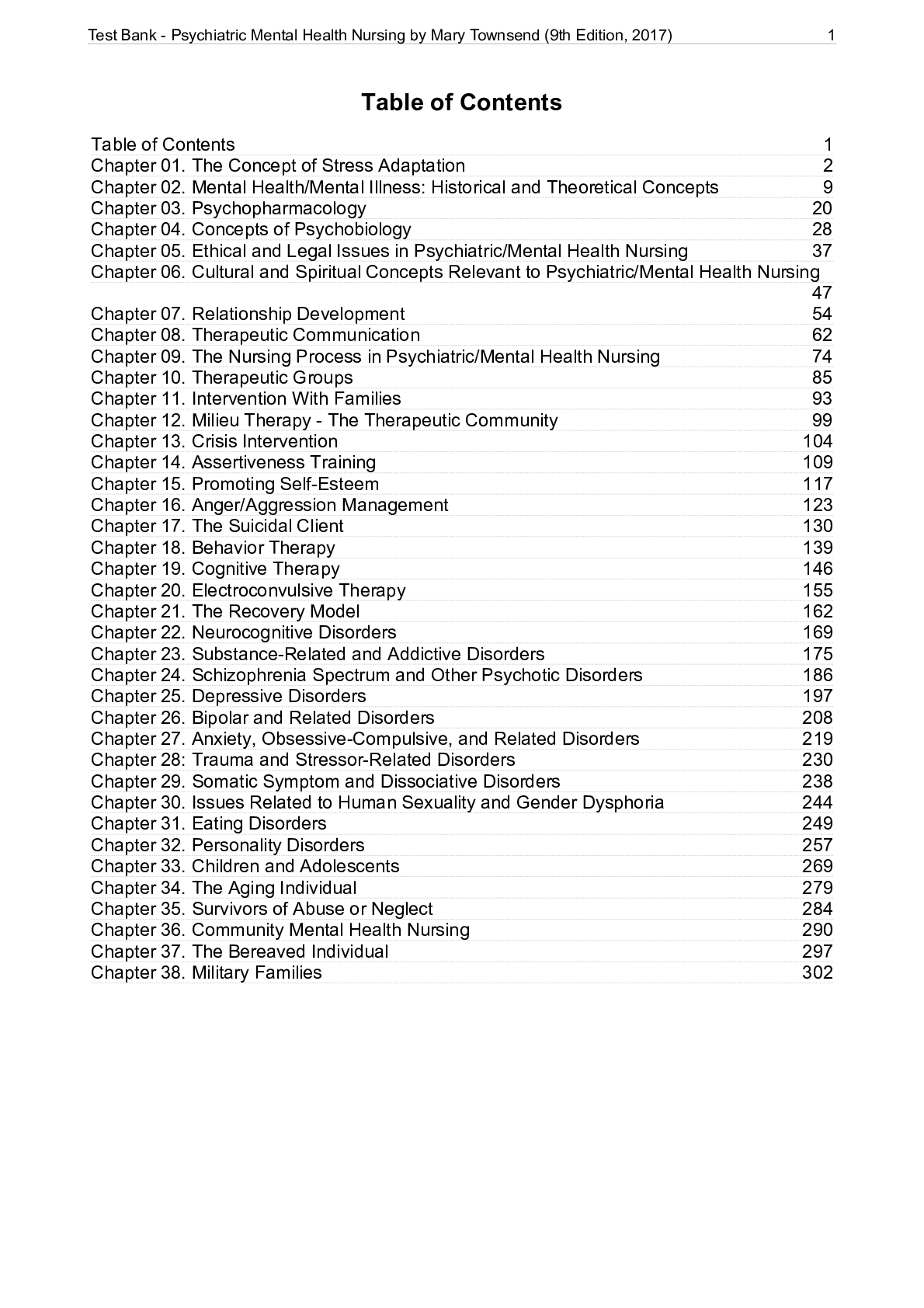
Test Bank - Psychiatric Mental Health Nursing by Mary Townsend / all chapters complete questions and answers / Test Bank - Psychiatric Mental Health Nursing by Mary Townsend (9th Edition)
Table of Contents Table of Contents Chapter 01. The Concept of Stress Adaptation Chapter 02. Mental Health/Mental Illness: Historical and Theoretical Concepts Chapter 03. Psychopharmacology Chapter 04...
By merit95 , Uploaded: Mar 30, 2021
$20
*NURSING> EXAM REVIEW > NUR 2349 Exam 3 exam review-3 complete questions and answers (All)
.png)
NUR 2349 Exam 3 exam review-3 complete questions and answers
NUR 2349 Exam 3 exam review-3 complete questions and answers
By klaus , Uploaded: Mar 02, 2021
$11
Programming> EXAM REVIEW > MIS 505 Final Exam Review 7 Chapter 4: Making Decisions > latest complete questions and answers (All)
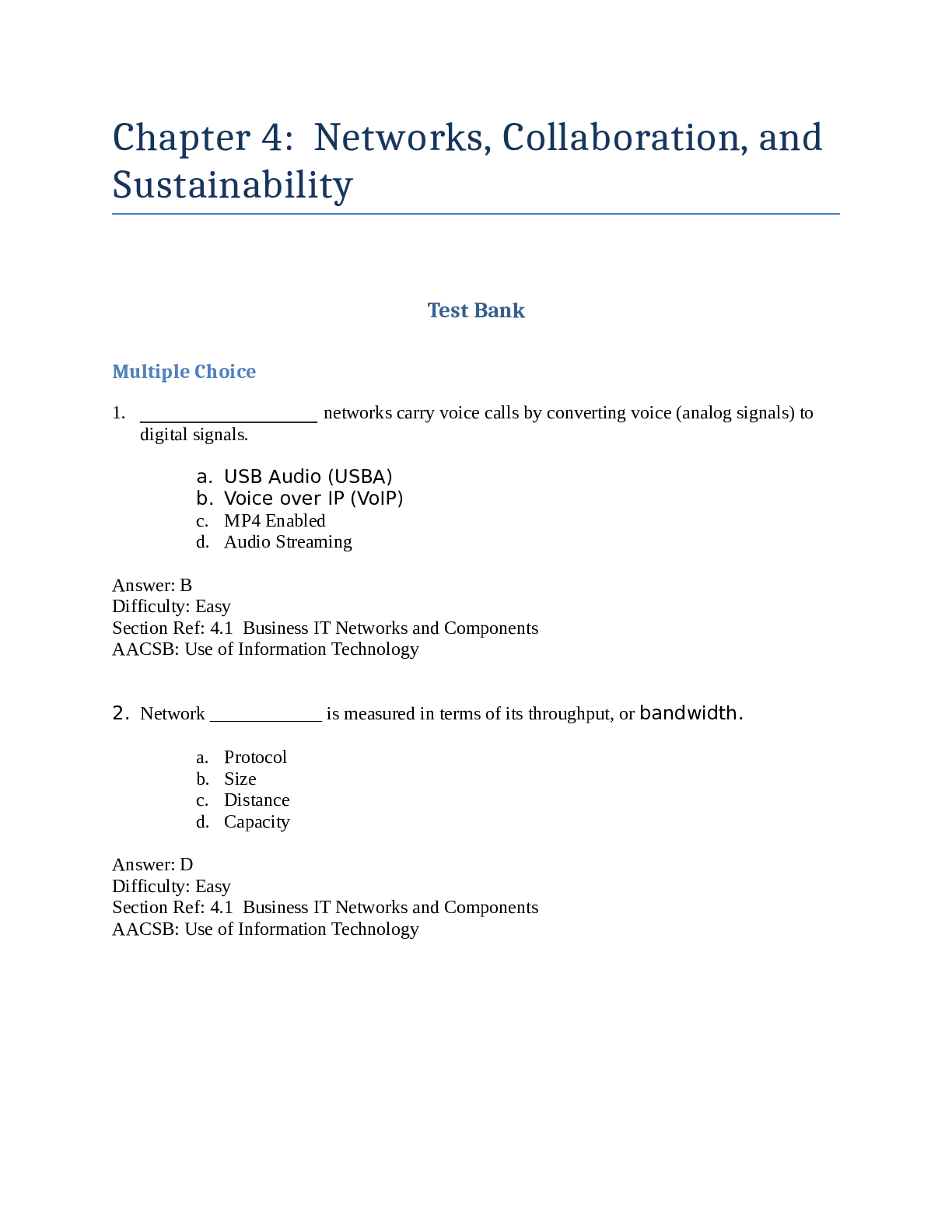
MIS 505 Final Exam Review 7 Chapter 4: Making Decisions > latest complete questions and answers
Questions: Review 7 Every decision you make in a computer program involves evaluating a Boolean expression. In any Boolean expression, the two values compared can … either variables or constants. A...
By CoursesExams , Uploaded: Dec 09, 2020
$15
Health Care> EXAM REVIEW > CPCE 2022-2023 COMPLETE QUESTIONS AND ANSWERS SOLVED SOLUTION (All)
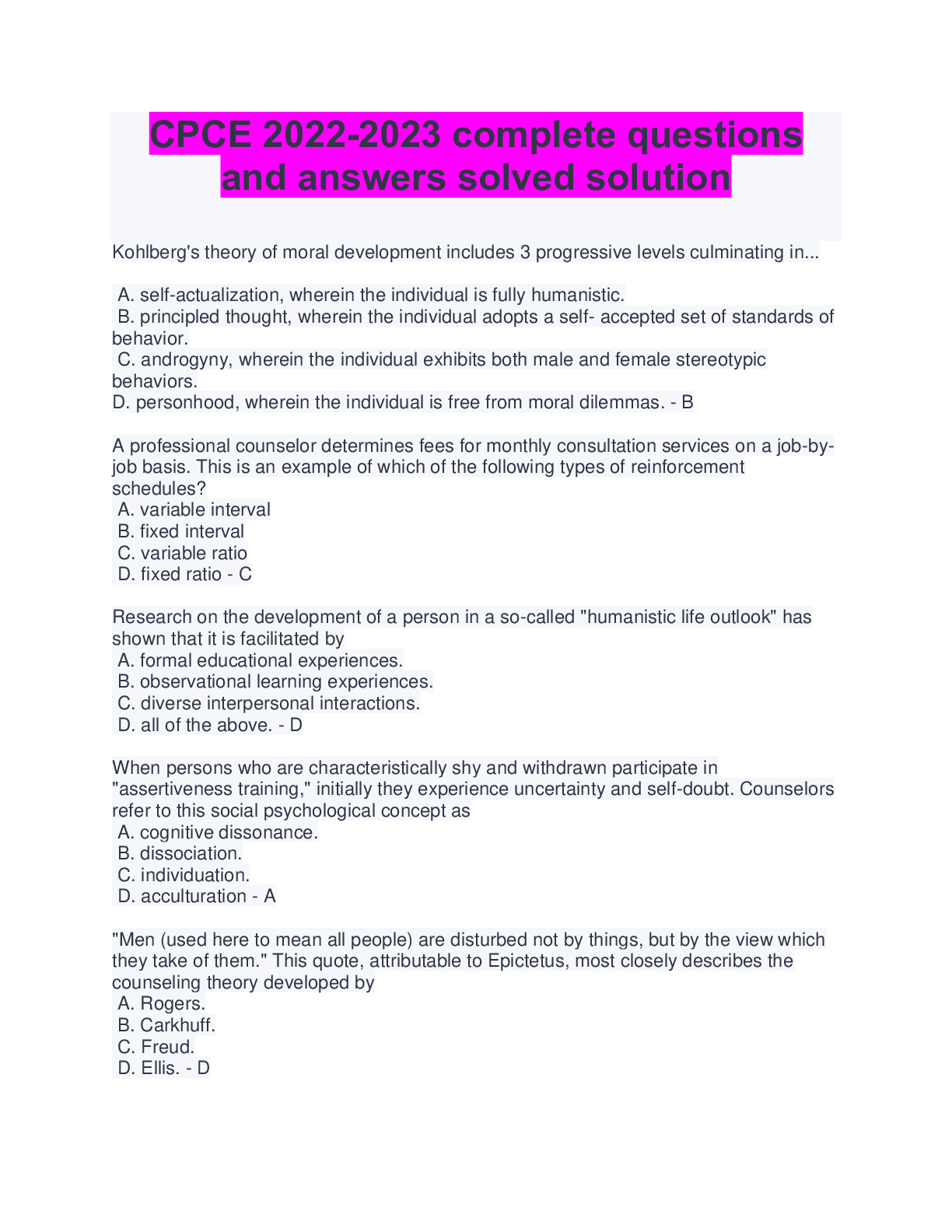
CPCE 2022-2023 COMPLETE QUESTIONS AND ANSWERS SOLVED SOLUTION
CPCE 2022-2023 COMPLETE QUESTIONS AND ANSWERS SOLVED SOLUTION
By quizprof , Uploaded: May 29, 2023
$12
*NURSING> EXAM REVIEW > NURS 6501 Midterm Exam Review Guide (Weeks 1-6. Compilation in 99 Pages) (All)
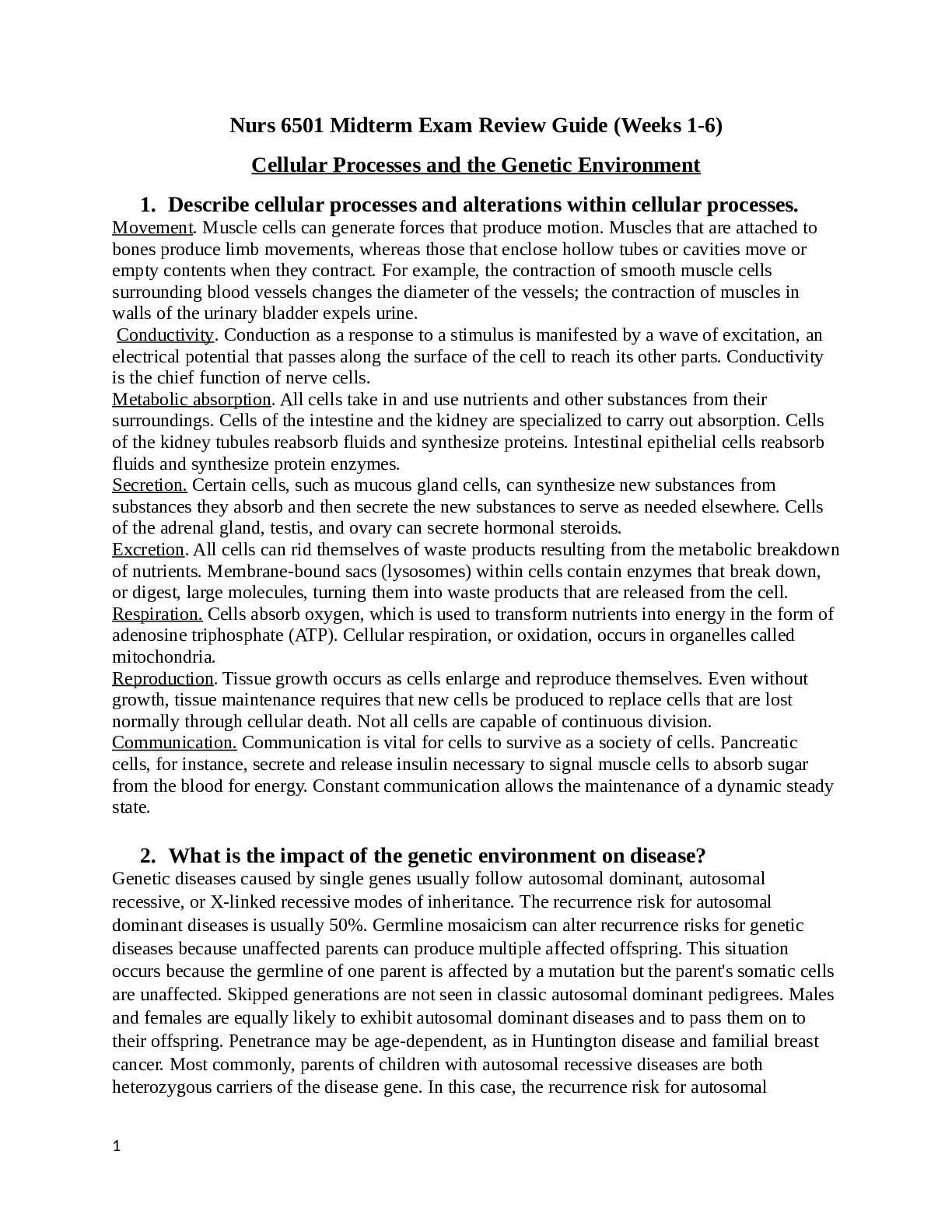
NURS 6501 Midterm Exam Review Guide (Weeks 1-6. Compilation in 99 Pages)
Nurs 6501 Midterm Exam Review Guide (Weeks 1-6) Cellular Processes and the Genetic Environment 1. Describe cellular processes and alterations within cellular processes. 2. What is the impact of t...
By SuperSolutions© , Uploaded: Nov 24, 2020
$15
*NURSING> EXAM REVIEW > NUR2063 / NUR 2063 Essentials of Pathophysiology Exam Review Latest Update Rasmussen College (All)
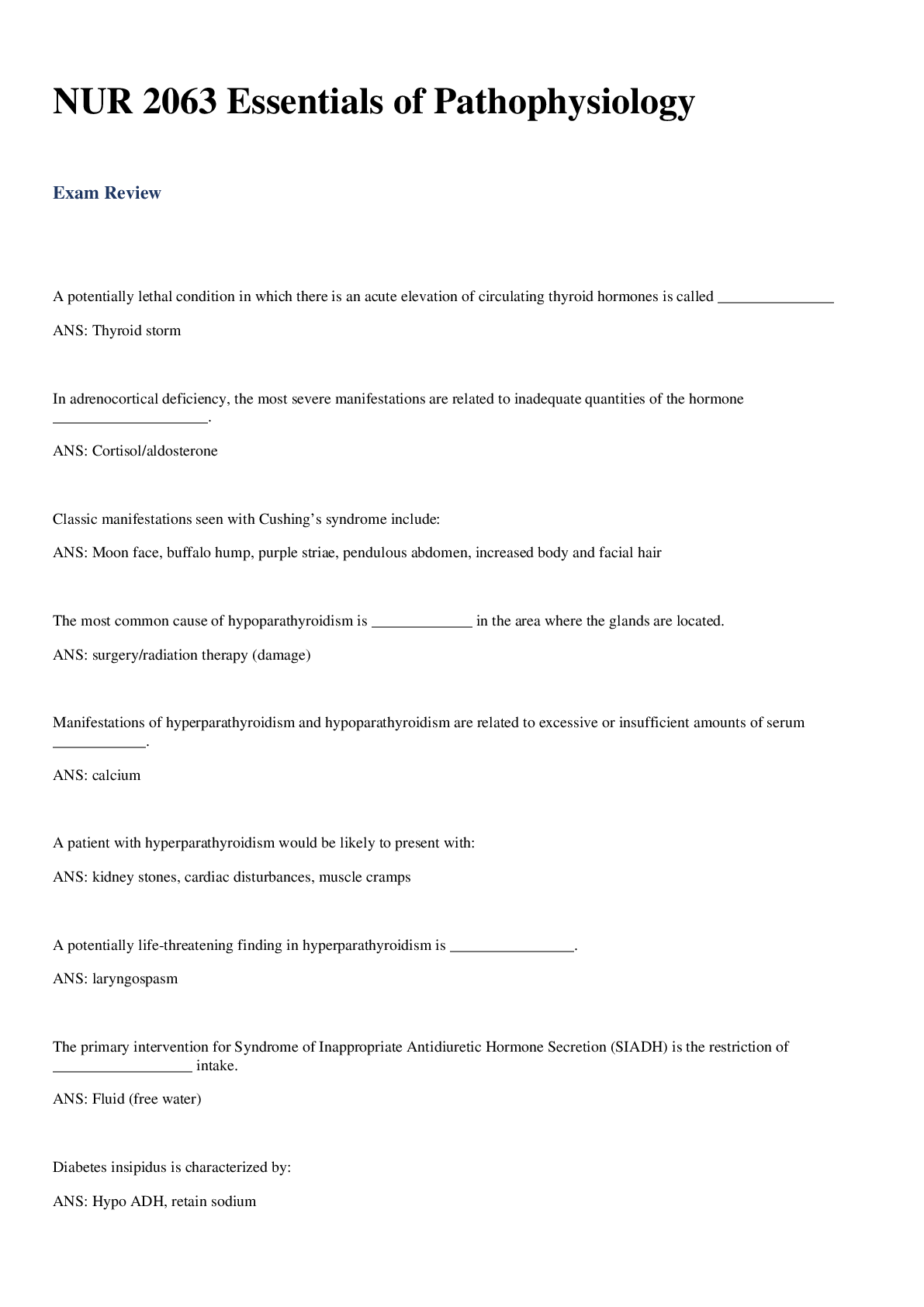
NUR2063 / NUR 2063 Essentials of Pathophysiology Exam Review Latest Update Rasmussen College
NUR 2063 Essentials of Pathophysiology Exam Review 1. A potentially lethal condition in which there is an acute elevation of circulating thyroid hormones is called _______________ - ANS: Thy...
By quiz_bit , Uploaded: Oct 28, 2020
$12
*NURSING> EXAM REVIEW > Multidimensional Care (MDC) 1 MDC EXAM 2 REVIEW -. (Rasmussen College) (All)
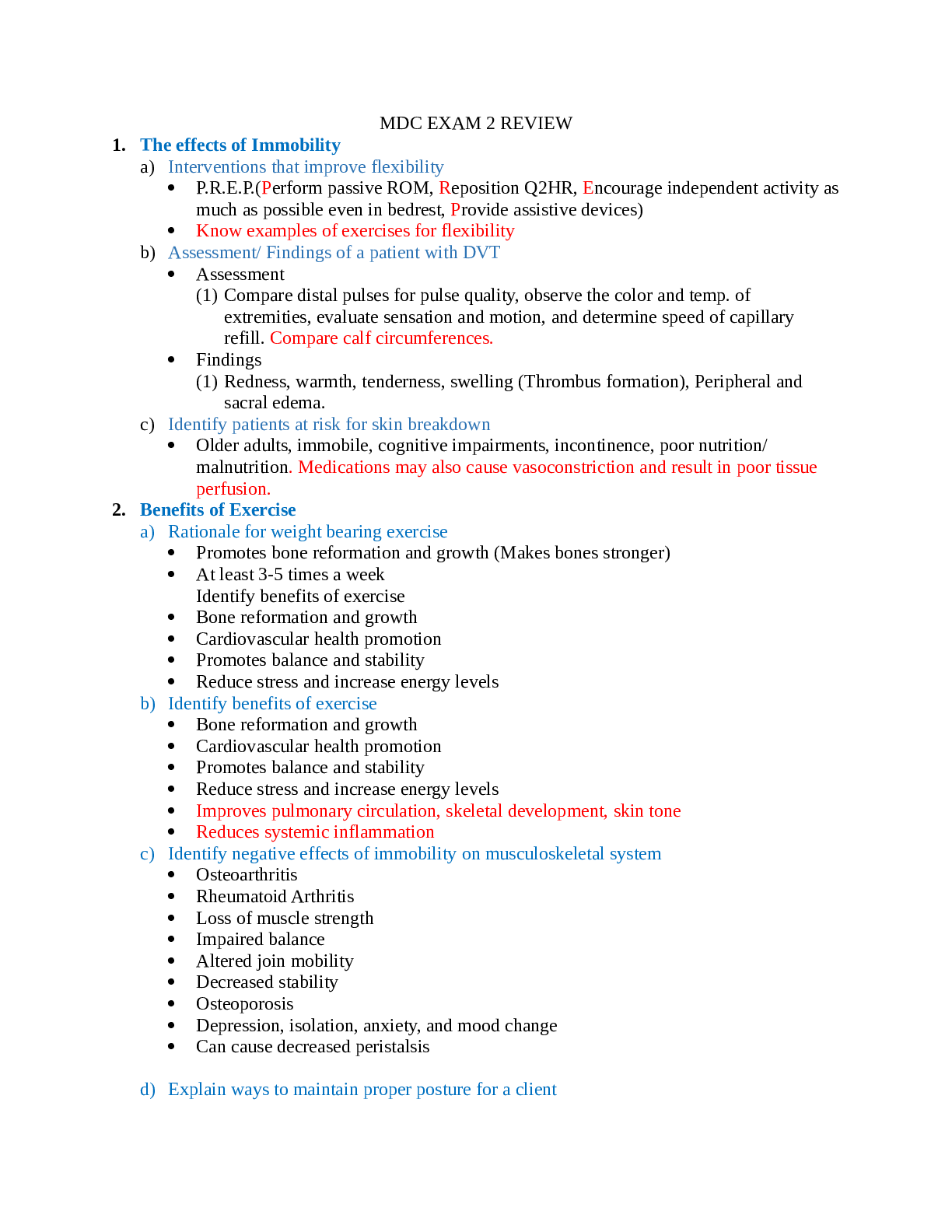
Multidimensional Care (MDC) 1 MDC EXAM 2 REVIEW -. (Rasmussen College)
MDC EXAM 2 REVIEW 11:19:19 1. The effects of Immobility a) Interventions that improve flexibility • P.R.E.P.(Perform passive ROM, Reposition Q2HR, Encourage independent activity as much as possible...
By SuperSolutions© , Uploaded: Dec 11, 2020
$11
Document information
Connected school, study & course
About the document
Uploaded On
May 07, 2021
Number of pages
47
Written in
Additional information
This document has been written for:
Uploaded
May 07, 2021
Downloads
1
Views
194






